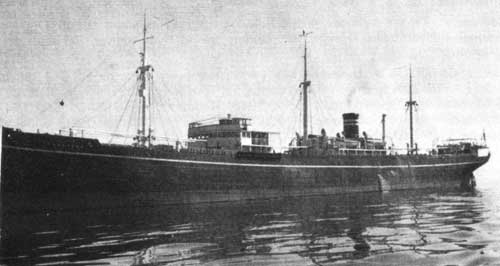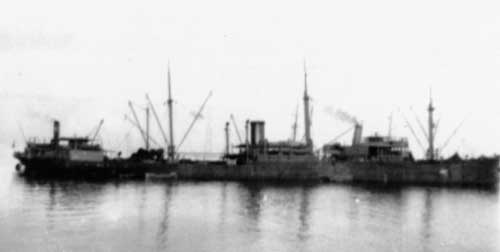| Site Map | Search Warsailors.com | |
|
M/S Tennessee To Tennessee on the "Ships starting with T" page.
Manager: Wilh. Wilhelmsen, Tønsberg Launched by Burmeister & Wain's Maskin- og Skibsbyggeri A/S, Copenhagen (Yard No. 324) on Aug. 1-1922, completed Sept. 28-1922. Captain: Einar Hansen. Related items on this website: Some of her voyages are listed on this original document received from the National Archives of Norway.
As can be seen from the above document, Tennessee arrived Thorshavn on Apr. 11-1940, 2 days after Norway was invaded by the Germans. She had initially been bound for Oslo, Norway, but was diverted to Leith. From Thorshavn, she proceeded to Kirkwall, remaining there for several weeks. I've been told that "Shipwreck Index of the British Isles" says the reason she called at Kirkwall was to have her cargo cleared by Contraband Control.
Tennessee ran aground on May 25-1940 in Roana Bay, Mainland, Orkney Islands, while returning to Kirkwall after having been in a collision with the British Baron Fairlie (6706 gt, built 1925), on a voyage from Calcutta and Kirkwall to Leith with general cargo (as already mentioned above, her intended destination had originally been Oslo, Norway - again, see the archive document). She had left Kirkwall that same morning in convoy with 7 other ships, Tennessee being the leading vessel. Shortly after departure, heavy fog had set in and her speed was reduced. According to Admiralty instructions the convoy was to stay together as far as Lerwick Head, then split up into 2 columns, with Tennessee as the first ship in the left column. From then on they were to steer to 58 59N 02 30W, but just before they were about to alter course at 13:05 they suddenly spotted a vessel on their port side, about 40 degrees forward of abeam, crossing their course about 50 meters away. Baron Fairlie's assigned station had been at the very rear of the convoy but she had passed all the other ships in the column for reasons unknown. Tennessee's attempts at avoiding her failed, and the British ship ran into her at about 13:08, hitting her on the port side near the bridge. This resulted in a 3' x 6' hole near the 'tweendeck on the port side and forward of Hold No. 3, which immediately started to flood, while Tennessee was listing heavily to port. An attempt was made to return to Kirkwall, but at 14:40 she ran aground in Roana Bay (east side of Deerness?) and was unable to refloat herself. With the help of a fishing vessel that came to, a tug was summoned from Kirkwall. After 2 unsuccessful attempts had been made to refloat her, the crew started to unload some of the cargo from Hold No. 1 and No. 2 and since they had no barges, about 130 tons were simply thrown overboard. A representative from the salvage company had come on board by this time, and at 14:40 (May 26) the tugs Imperious, Charing Cross and Brigand tried to get her off the ground, but she would not budge. 2 divers from one of the tugs then went down to investigate and found her bow to be grounded along a length of about 20'. The following day, May 27, unloading of cargo from the 2 holds was resumed, aided later that day by 22 men from shore. Cargo was also discharged from No. 3 Hold. After 280 tons had been taken off another attempt was made by the tugs to get her refloated at 16:25, but to no avail. They now found that water had penetrated the starboard and port No. 2 tanks as well as the engine room, rising quickly in the latter in spite of the pumps being in continuous use. In the increasing winds, with the water rising in the engine room and leaks in No. 4 and No. 5 tanks, it now appeared she could not be saved. By 02:00 (May 28) her upper port deck was in the water, and eventually the situation became so critical that the majority of the crew members were taken off by one of the tugs which headed to Kirkwall with them. 7 men had remained on board, but they were also taken off when the situation worsened, while a man from shore was sent out to keep watch over the ship. The captain went out every day to check on her. She was eventually declared a total loss, but much of her cargo was salvaged. In fact, according to this thread on my Ship Forum the locals have quite a bit of "Tennessee items" in their various residences to this day. See also this posting (it'll be noticed, that the salvage boat Bertha is also mentioned, as are cargo boats Fernside and Edinmore, which are said to have removed cargo from Tennessee, among which was teak and "monkey nuts"). She's still a popular spot for divers. The maritime hearings were held in Newcastle-on-Tyne on Aug. 6-1940 with the captain and the 2nd mate appearing. In the captain's opinion the collision took place because of faulty maneuvering on the part of the British ship, having altered course in the fog on her own initiative without knowing Tennessee's course and position. With regard to the subsequent grounding, he blames the fog as well as "unusual and incalculable current" which must have taken her out of course. Estimated position according to course and distance covered was 59 00N 02 45W, 9 miles east/southeast of Lerwick Head (I've also seen position given as 58 59N 02 27W). The forum posting mentioned above says the area where she grounded is locally called "Tammy Tiffy" rocks.
Crew List - No Casualties:
A the time of the collision, the 2nd mate was on duty on the bridge; the captain was also on the bridge. Helmsman was Kaare Hegstad, and Arne Lund was on lookout duty on the forecastle. Tennessee also had 2 consular passengers on board, 1 of whom had come on board in Calcutta, the other in Port Said. The 2nd engineer also served on Skum.
Back to Tennessee on the "Ships starting with T" page. This was the first in a line of 4 ships by this name. The text on this page was compiled with the help of: "Nortraships flåte", J. R. Hegland, Wilh. Wilhelmsen's fleet list, "Sjøforklaringer fra 2. verdenskrig", Norwegian Maritime Museum, Volume II (all listed in My sources).
|



